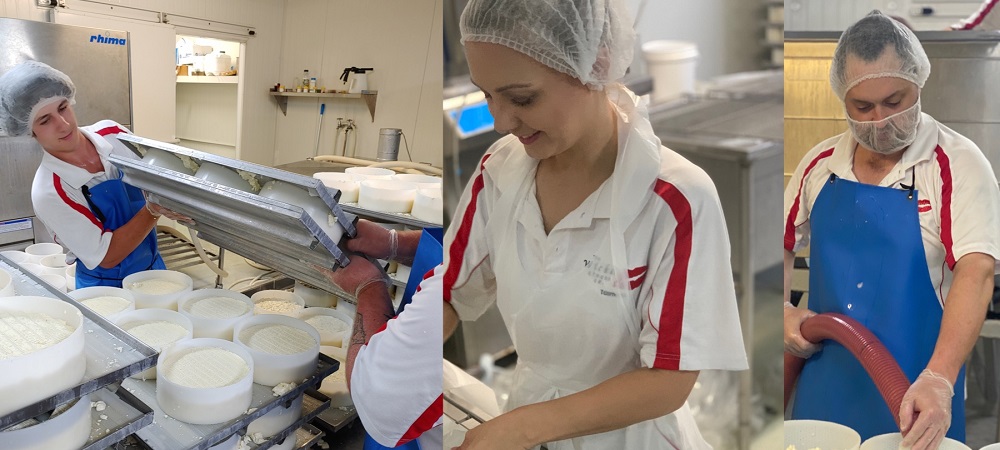The Very Best of Melbourne Made Cheese: Floridia Cheese Melbourne's Special Offerings
The Very Best of Melbourne Made Cheese: Floridia Cheese Melbourne's Special Offerings
Blog Article
Unlocking the Tricks of Artisanal Cheese Making: A Step-by-Step DIY Overview
In the realm of culinary craftsmanship, artisanal cheese making stands as a testament to the delicate equilibrium in between tradition and technology. As we embark on this journey to debunk the art of producing splendid cheeses, we are faced with a tapestry of secrets and abilities waiting to be unraveled.
Picking the Right Milk
When embarking on the trip of artisanal cheese making, the option of milk plays an important duty in determining the quality and qualities of the final item. The kind of milk selected impacts the taste, appearance, and generally profile of celebrity. Raw milk, right from the animal, is favored by numerous artisanal cheesemakers because of its distinct blend of enzymes, microorganisms, and flavor substances. Nevertheless, making use of raw milk includes threats and guidelines, making sterilized milk a much safer choice for beginners.
Furthermore, the resource of the milk, whether from cows, goats, lamb, or buffalo, contributes unique tastes and characteristics to the cheese. Each type of milk brings its own subtleties, permitting for a vast range of cheese varieties to be crafted based on the chosen milk.
Culturing and Coagulating
To launch the cheese-making procedure, the essential steps of culturing and coagulating should be thoroughly carried out to change milk right into curds and whey. Culturing includes introducing helpful germs to the milk, which after that begins the fermentation process. These bacteria transform lactose (milk sugar) right into lactic acid, producing the acidic atmosphere required for coagulation. The type of culture used can considerably impact the taste, appearance, and ripening of the final cheese item.

The timing and temperature control during culturing and coagulation are essential aspects that influence the final outcome of celebrity. Appropriate implementation of these actions is important to ensure the wanted structure, taste, and consistency of the artisanal cheese being produced.
Draining Pipes and Pressing Curds
After the milk healthy proteins have coagulated and the curds have actually been cut to launch whey, the next critical step in artisanal cheese making involves draining pipes and pressing the curds to accomplish the desired structure and uniformity of the final cheese item. Draining pipes is the process of separating the curds from the whey. This can be done by moving the curds into a cheesecloth-lined colander or mold and mildew and allowing the whey to drain off normally. The time for draining pipes can differ depending on the kind of cheese being made and the wanted moisture material.
Pressing assists remove any type of remaining whey and compacts the curds to form a solid cheese wheel. Proper draining and pushing are critical actions that dramatically impact the quality and features of the artisanal cheese being generated.
Aging and Flavor Techniques
Executing careful aging and flavoring techniques is pivotal in boosting the deepness and complexity of artisanal cheeses, elevating their preference accounts to beautiful levels of improvement and sophistication. Aging plays an important role in creating the one-of-a-kind tastes and structures that distinguish artisanal cheeses. Throughout the aging process, cheeses are saved in carefully regulated settings where elements such as humidity, temperature level, and air flow are controlled to encourage the development of useful molds and microorganisms. This controlled setting enables celebrity to grow gradually, establishing intricate aromas and abundant tastes.
Seasoning techniques also contribute dramatically to the last preference of artisanal cheeses. Cheesemakers might select to present added flavors by including ingredients such as herbs, flavors, or perhaps fruits right into celebrity throughout the production process. Furthermore, some cheeses this post are cleaned or massaged with numerous fluids, such as salt water or alcohol, to enhance their flavors and structures.
Covering and Saving Cheeses

Verdict
To conclude, understanding the why not try here art of artisanal cheese making involves meticulously selecting the ideal milk, following exact culturing and coagulating procedures, draining and pressing curds properly, and utilizing different aging and flavor techniques. By complying with these actions diligently and with interest to information, you can create your own tasty and one-of-a-kind cheeses in the house. Keep in mind to wrap and save your cheeses appropriately to guarantee optimal taste and structure advancement. Satisfied cheese making!
Each kind of milk brings its own nuances, enabling for a broad variety of cheese varieties to be crafted based on the selected milk.After the milk healthy proteins have coagulated and the curds have been cut to release whey, the following essential step in artisanal cheese making involves draining pipes and pushing the curds to attain the preferred structure and consistency of the final cheese item. The majority of cheeses need to be wrapped in wax paper or a knockout post cheese paper to allow them to breathe while protecting them from drying out. For cheeses that require to proceed aging, such as bloomy rinds or washed peels, guarantee they are kept in a great atmosphere like a cheese cave or a fridge established to the proper temperature. By paying attention to the wrapping and storage of artisanal cheeses, cheese manufacturers and fanatics can protect the integrity of these delicacies and totally enjoy their complex tastes.
Report this page